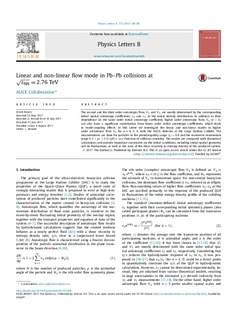Linear and non-linear flow mode in Pb–Pb collisions at √sNN=2.76TeV
Acharya, Shreyasi; Adamová, Dagmar; Adolfsson, Jonatan; Aggarwal, Madan M.; Aglieri Rinella, Gianluca; Agnello, Michelangelo; Agrawal, Nikita; Ahammed, Zubayer; Ahmad, Shafiq F.; Ahn, Sang Un; Alme, Johan; Altenkaemper, Lucas; Djuvsland, Øystein; Lønne, Per-Ivar; Nystrand, Joakim; Rehman, Attiq ur; Røhrich, Dieter; Tambave, Ganesh Jagannath; Ullaland, Kjetil; Velure, Arild; Wagner, Boris; Zhang, Hui; Zhou, Zhuo; Zhu, Hongsheng; Arsene, Ionut Christian; Bätzing, Paul Christoph; Dordic, Olja; Lardeux, Antoine Xavier; Lindal, Svein; Mahmood, Sohail Musa; Milosevic, Jovan; Richter, Matthias; Røed, Ketil; Skaali, Toralf Bernhard; Tveter, Trine Spedstad; Wikne, Jon Christopher; Zhao, Chengxin; Helstrup, Håvard; Hetland, Kristin Fanebust; Kileng, Bjarte; Nesbø, Simon Voigt; Langøy, Rune; Lien, Jørgen; Aiola, Salvatore; Akindinov, Alexander; Alam, Sk Noor; Alba, José Luis Bazo; De Albuquerque, Danilo Silva; Aleksandrov, Dimitry; Alessandro, Bruno; ALICE, Collaboration
Journal article, Peer reviewed
Published version
Permanent lenke
http://hdl.handle.net/11250/2501559Utgivelsesdato
2017Metadata
Vis full innførselSamlinger
- Institutt for mikrosystemer [546]
- Publikasjoner fra CRIStin [3623]
Sammendrag
The second and the third order anisotropic flow, V2and V3, are mostly determined by the corresponding initial spatial anisotropy coefficients, ε2and ε3, in the initial density distribution. In addition to their dependence on the same order initial anisotropy coefficient, higher order anisotropic flow, Vn(n >3), can also have a significant contribution from lower order initial anisotropy coefficients, which leads to mode-coupling effects. In this Letter we investigate the linear and non-linear modes in higher order anisotropic flow Vnfor n =4, 5, 6 with the ALICE detector at the Large Hadron Collider. The measurements are done for particles in the pseudorapidity range |η| <0.8and the transverse momentum range 0.2

